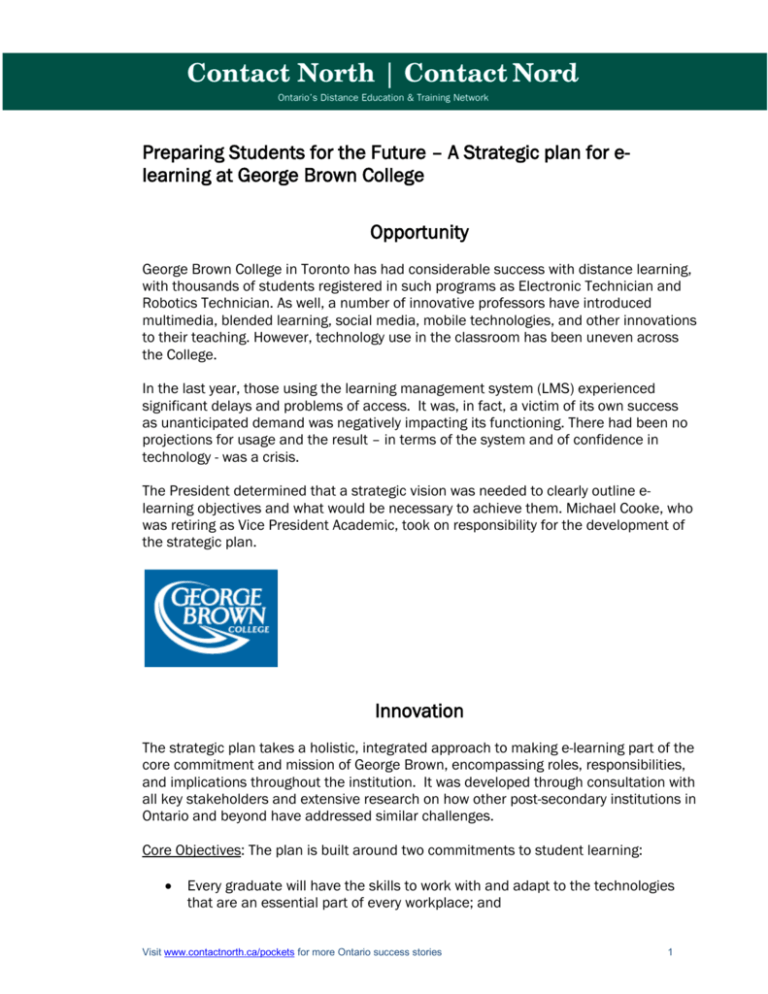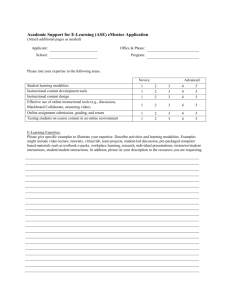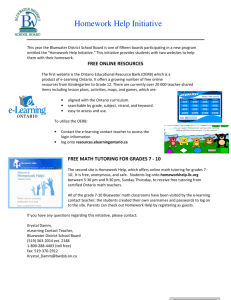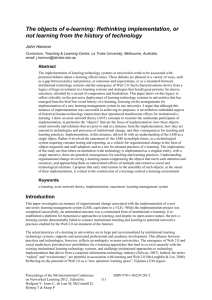Preparing Students for the Future – A Strategic plan
advertisement

Preparing Students for the Future – A Strategic plan for elearning at George Brown College Opportunity George Brown College in Toronto has had considerable success with distance learning, with thousands of students registered in such programs as Electronic Technician and Robotics Technician. As well, a number of innovative professors have introduced multimedia, blended learning, social media, mobile technologies, and other innovations to their teaching. However, technology use in the classroom has been uneven across the College. In the last year, those using the learning management system (LMS) experienced significant delays and problems of access. It was, in fact, a victim of its own success as unanticipated demand was negatively impacting its functioning. There had been no projections for usage and the result – in terms of the system and of confidence in technology - was a crisis. The President determined that a strategic vision was needed to clearly outline elearning objectives and what would be necessary to achieve them. Michael Cooke, who was retiring as Vice President Academic, took on responsibility for the development of the strategic plan. Innovation The strategic plan takes a holistic, integrated approach to making e-learning part of the core commitment and mission of George Brown, encompassing roles, responsibilities, and implications throughout the institution. It was developed through consultation with all key stakeholders and extensive research on how other post-secondary institutions in Ontario and beyond have addressed similar challenges. Core Objectives: The plan is built around two commitments to student learning: • Every graduate will have the skills to work with and adapt to the technologies that are an essential part of every workplace; and Visit www.contactnorth.ca/pockets for more Ontario success stories 1 • Every graduate will have the experience and comfort necessary with e-learning to make it an indispensable tool for lifelong learning – both at work and play. Key Components: The plan blends together the re-design of curriculum and content, the training and support of professors, and the development and maintenance of infrastructure, highlighting three essential elements: • Standards defined for students, faculty, and programs specifying goals. For example, every student must take at least one online course and all courses are to be enabled through the LMS. • An ambitious program of support for professors, including instructional design, training, and technology support, so that they can meet the standards. • Analytical and evaluative tools developed, adapted, and implemented to assess performance against goals and standards and to support evidence-based decision making on where to invest resources. Projections: The plan includes detailed projections concerning the number of faculty involved, the training provided, the number of courses re-designed, the investment required, bandwidth needed, the need for ongoing support for faculty and students, and the impact on infrastructure. Year one of implementation is 2012- 2013, with 75% of the standards to be reached by 2016. Pedagogy: At the core of the plan and the resource expenditure are instructional design and e-learning pedagogy. As Michael Cooke describes it, “We require a reconceptualization of pedagogy as we look at how e-learning reframes George Brown’s commitment to excellence.” Central to this is the Department of Learning Innovations and Academic Development which, as an example of the new strategic direction, will move from supporting a compulsory computer literacy course and online testing, to a focus on innovation in instructional design and evidence-based planning for e-learning. Elements of Success: To be successful, the strategy requires a high level of collaboration across the College, including the Vice President Academic, the Chief Information Officer, human resources, the library, the registrar’s office, and departments involved with student and academic services. It already has some elements essential to success, with presidential endorsement, a comprehensive investment plan, and the fertile ground created by the innovations of individual professors. Two of these projects are featured in this series: • • RISK – A student-centred pedagogical model for teaching and learning Mobile Assisted Language Learning – Enhancing student learning with mobile phones Visit www.contactnorth.ca/pockets for more Ontario success stories 2 Acknowledging the Issues: The College recognizes some of the issues and challenges that it will likely encounter with the implementation of the plan, such as varied student access to technologies and to data plans and the need to develop resources for multiple formats. This diversity has to be respected and solutions sought, while technology enhancements and ownership patterns change over the years of the plan. Change Model: The change starts at the program level so that each student will be obliged to take one online course to graduate. The Chairs, Deans, and Coordinators will determine the best courses to re-design for online learning to reach this goal. Technology Use and Training: As well as having the training to take full advantage of the capacities of the LMS (Blackboard 9.1), professors will also be supported in the use of social media, mobile devices, lecture capture, and various collaborative learning tools. As new faculty are recruited, many of them will bring familiarity with the technology, needing support concerning the pedagogical applications. Outcomes and Benefits The integration of e-learning responds to the demands and the needs of students. The access and flexibility for students to learn anywhere and anytime, respects their multiple roles as employees, parents, community members, as well as students. The plan addresses the concerns expressed by some students about the slow integration of technology into the College and the inconsistent use of technology in their courses. The strategic plan has been developed with student learning as the central, critical outcome – learning to use and adapt to technologies, and learning how to learn with technology. As well, it provides the instructional, academic, and infrastructure support for the development of programs, courses, and resources that are pedagogically sound and make the most of the strengths of technologies. During February 2012, the plan is being considered by the Academic Management Committee of Deans and the Senior Management Committee, with possible adoption as of April 1, 2012. Challenges and Enhancements Among the greatest challenges with a comprehensive plan is creating the seamless alignment and relationships necessary among the stakeholders, especially the Vice President Academic and the Chief Information Officer. As the move to e-learning implies long-term capacity building, the change must be sustained and supported even in times of fiscal restraint. Visit www.contactnorth.ca/pockets for more Ontario success stories 3 Potential Michael Cooke is very keen to share the experience at George Brown College with other institutions. Once the plan is approved and the standards are finalized, they can be provided for other colleges and universities to adapt to their purposes. As well, the documentation that he gathered on the practices and learning of other institutions can be shared electronically. For Further Information Michael Cooke Advisor to the President George Brown College mcooke@georgebrown.ca Visit www.contactnorth.ca/pockets for more Ontario success stories 4





